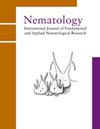Effects of cover crops on hatching of and root penetration by Heterodera glycines
IF 1.1
4区 生物学
Q2 ZOOLOGY
引用次数: 0
Abstract
The use of non-host cover crops can be a viable strategy for managing soybean cyst nematode (SCN) Heterodera glycines. Cover crops may affect SCN biology and reduce populations by acting as trap crops that promote the hatching and/or penetration by second-stage juveniles (J2) without supporting their development. Two growth chamber experiments were conducted to assess ten cover crops for their impacts on SCN hatching and penetration into the roots. For each experiment, with four replications per treatment, crops were planted in naturally-infested soil in two separate sets to be harvested 15 and 30 days after planting (DAP). SCN susceptible soybean ‘Barnes’ and non-planted natural soil (fallow) were used as controls. Faba bean ‘Petite’, a non-host of SCN, induced the greatest hatching among the cover crops and was statistically similar to soybean. Winter rye ‘ND Dylan’ also induced significant hatching compared to fallow. Root staining revealed that the highest number of J2 penetrated the faba bean roots at 15 DAP, followed by soybean and winter rye. While J2 penetrated all tested crops, they completed their development to become adult females only in soybean and turnip. Soybean cyst nematode development to adult females did not occur in faba bean, and the number of SCN inside the faba bean roots 30 DAP was significantly lower than at 15 DAP and also lower than in soybean. These results suggest that the faba bean affects SCN biology and has the greatest potential to act as a trap crop for managing SCN.覆盖作物对甘蓝杂环虫孵化和根系穿透的影响
利用非寄主覆盖作物是控制大豆包囊线虫(SCN)的一种可行策略。覆盖作物可能作为诱捕作物,促进第二阶段幼鱼(J2)的孵化和/或渗透,而不支持它们的发育,从而影响SCN生物学并减少种群数量。通过两个生长室试验,评价了10种覆盖作物对SCN孵化和根系渗透的影响。在每个试验中,每个处理4个重复,将作物分两组种植在自然侵染的土壤中,播种后15天和30天收获(DAP)。以对SCN敏感的“巴恩斯”大豆和未种植的自然土壤(休耕)为对照。非SCN寄主的蚕豆‘Petite’在覆盖作物中诱导孵化率最高,与大豆相似。与休耕相比,冬黑麦' ND Dylan '也诱导了显著的孵化。根系染色结果显示,15dap时,J2渗透蚕豆根系的数量最多,其次是大豆和冬黑麦。虽然J2能穿透所有被试作物,但它们只在大豆和萝卜中完成发育成为成虫。大豆包囊线虫在蚕豆中未发育成雌,30 DAP的蚕豆根内SCN数量显著低于15 DAP,也低于大豆。这些结果表明蚕豆影响SCN生物学,并且最有可能作为控制SCN的诱捕作物。
本文章由计算机程序翻译,如有差异,请以英文原文为准。
求助全文
约1分钟内获得全文
求助全文
来源期刊

Nematology
生物-动物学
CiteScore
2.60
自引率
33.30%
发文量
67
审稿时长
3 months
期刊介绍:
Nematology is an international journal for the publication of all aspects of nematological research (with the exception of vertebrate parasitology), from molecular biology to field studies. Papers on nematode parasites of arthropods, and on soil free-living nematodes, and on interactions of these and other organisms, are particularly welcome. Research on fresh water and marine nematodes is also considered when the observations are of more general interest.
Nematology publishes full research papers, short communications, Forum articles (which permit an author to express a view on current or fundamental subjects), perspectives on nematology, and reviews of books and other media.
 求助内容:
求助内容: 应助结果提醒方式:
应助结果提醒方式:


